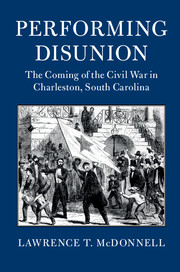17 - A True Index of Character
from CRISIS: FIRE AND SWORD
Published online by Cambridge University Press: 08 June 2018
Summary
Antebellum America struggled with the divided nature of volunteer fire service, alternately brawling and stoic. But not in Charleston. “Charleston,” declared Louis Tasistro in 1842, “excels every other city … in the organization of its fire department.” By mid- century, its membership differed from other cities’ “vastly” in regard to harmony and unison. “You never see any of those disgraceful rows, quarrels, riots, &c., indulged in by companies of some cities … which so degrade a Fireman in the estimation of the community.” In contrast to the North, “where an alarm of fire is the certain prelude to a riot,” a spirit of camaraderie prevailed among the Queen City's volunteers. “No fire riot has ever been known in Charleston,” John Honour asserted. Here, fire and crisis drew volunteers into an apparently solid column.
That was the nominal theme of the 1841 portrait Christian Mayer painted of the leaders of Charleston's white fire companies posed in front of the Fireproof Building. Though their hats and military- style uniforms vary considerably, the men who wear them look much the same: placidly confident, well- groomed, respectable. There is a “spirit of courtesy” and mutual respect about the scene. Like those they commanded, “all seem to be anxious to discharge their duty quietly and peaceably, feeling the truth of the old maxim, that ‘Union is Strength.’ “ All are brother firemen, models of character and achievement. Looking solidly bourgeois, the first men of the department ranked among the first men of the city: three mayors, half a dozen aldermen, prosperous merchants, and shopkeepers. Collectively, they combine the heart, daring, and dedication of Mose with the good order and respectability Currier and Ives idealized. “A country where so many estimable citizens are willing to risk their lives for the safety of the community,” Tasistro thought, “need never stand in fear of invasion by a foreign foe.”
But it was internal division, not foreign foes, that plagued South Carolina. A closer look at Mayer's painting shows a different scene, readily apparent to residents in the 1840s. There is a lack of order or hierarchy in this picture.
- Type
- Chapter
- Information
- Performing DisunionThe Coming of the Civil War in Charleston, South Carolina, pp. 341 - 357Publisher: Cambridge University PressPrint publication year: 2018



